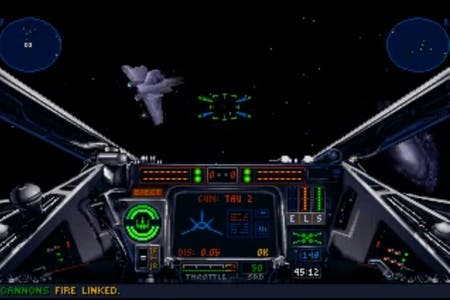X-Wing Retrospective
When the Force was still with us.
By the mid '90s, we PC gamers thought we had it all, and perhaps we did. Gaming on a console was almost unthinkable when the holy glow of your monitor brought the divine action of Doom, the coy humour of the Monkey Island adventures, the grim strategy of UFO: Enemy Unknown and the quick-fire tactics of Command & Conquer. We had sports games aplenty and simulators coming out of our ears, games that let us pilot planes, tanks, helicopters, even submarines. We were starting to play these games together through the internet and dedicated graphics cards were just around the corner. It was a glorious, glorious time to be a gamer.
We also had all the best Star Wars games, hands down, and anyone who tried to argue for that Super Star Wars nonsense was laughed out the room and was about as welcome as a fart on a date. We had Dark Forces which, y'know, was pretty neat (it wasn't even PC first-person shooters at their finest, but we liked it, we let it hang with our crowd) and we had X-Wing. And X-Wing was cool.
No, I'm lying. X-Wing was much more than just cool. It was quick, sleek, deadly and impossibly exciting. It was the embodiment of Star Wars, everything that the original trilogy stood for, distilled and bottled and presented to you as an elixir of pure excitement. It was all that action, all those battles against the odds, all those attempts to grasp victory with the sweaty, desperate hands of a brash young freedom fighter, and more than any other Star Wars game before it (and perhaps since), it was able to give you your own place in George Lucas' universe. When you settled into the cockpit of your starfighter, you were taking your first step into a larger world.
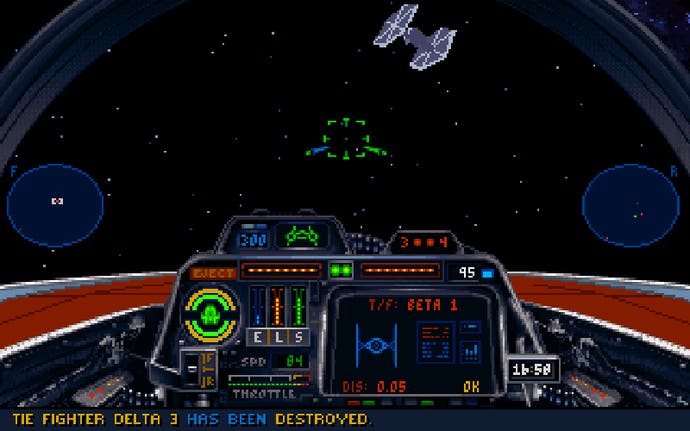
X-Wing was fast. More than a few gamers were used to the more measured Wing Commander space-sims, or earthbound flight simulators that were always concerned with gravity and drag and every force but the Force, but X-Wing slipped the surly bonds of Earth and practically stood on the gas pedal.
With no need to build a conventional, realistic flight model, Totally Games made something that was all about speed and agility, each dogfight a spiralling, twisting melee where the enemy might grace your sights for but a fraction of a second, every attack run a weaving, winding game of chicken. It wasn't that you became addicted to this speed so much as you realised it was what kept you alive in a cloud of fragile but nimble TIE fighters.
So you were desperately trying to squeeze the best out of each of the starfighters whose seats graced your backside. Quick to realise that the Y-Wing was the Volvo of the Rebel Alliance, you did your best to wrest this heavy-set beast to your will, frequently diverting extra power to the fatty layers of shields that coated your cockpit.
The A-Wing was a hornet in comparison, quick and nimble, yet easily swatted by a few heavy laser bolts, but the temptation was always there to plough energy into your engines and see just how fast the thing could get. As for the titular X-Wing, it had four lasers. Four lasers, all making that characteristic Star Wars spitting sound as you gleefully spun your way into another dogfight.
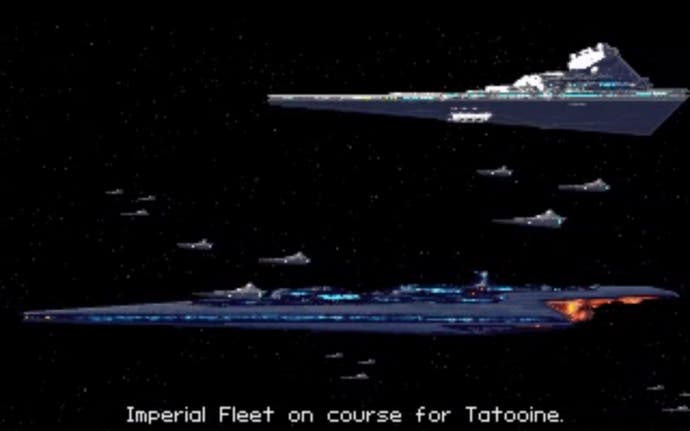
Key to managing all these starfighters was a smart and yet very simple system of power balancing. Your engines, lasers and shields all drew energy from your power plant, but increasing the supply to one always weakened another. The thrill of speed came at the expense of shielding or firepower, while even a gentle charging of your shields or weapons brought an unpleasant performance hit in a galaxy where being sluggish could (and did) cost you dearly.
Time really was of the essence as the space around you thickened with fighters and frigates alike. Missions didn't always go according to plan and you could bet that, when your commanding officer told you that enemy forces may scramble in response to your team's ambush, you could well expect some sort of Imperial entanglement.
You might be desperately trying to finish off a merchant vessel, only to see the dagger of a Star Destroyer thrust its way out of hyperspace and immediately scramble fighters. How long before they would intercept you? A minute? How long can you leave your allies undefended for? Do you have the time to break off from your main objective to intercept bombers heading for the medical frigate? Sure you do - just switch off your shields and jam the throttle forward. What could possibly go wrong?
When you weren't balancing your energy levels you were see-sawing your priorities, trying to keep abreast of the battle about you, casting another quick glance at your map and growling as your R2 unit told you your lasers won't be repaired for another 20 seconds. 20 seconds? Nobody has that kind of time, not when an enemy corvette is about to leap into hyperspace, escaping forever with whatever secret cargo it's carrying.
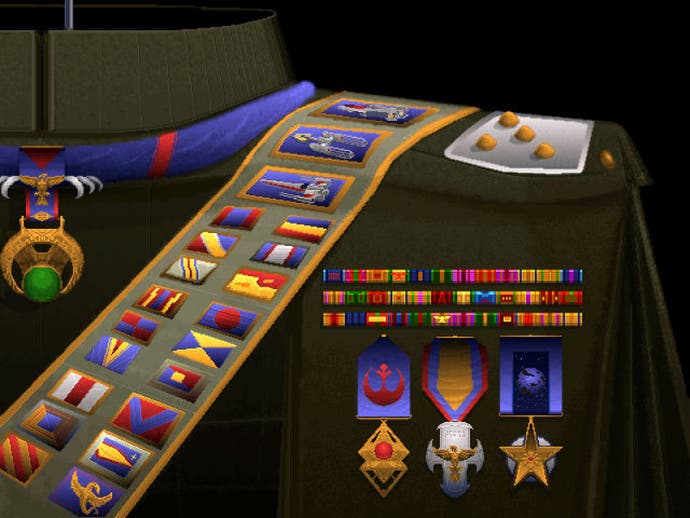
X-Wing was a looker for its time, too. We might snigger now at a pixellated Darth Vader shuffling his way through a cutscene, but it very much looked and felt like Star Wars should, so much more than any of the cartoony platformers or vector graphics games that had come before. It captured that glossy and yet slightly worn lived-in universe that Lucas had created. For the first time ever, a game showed us the Star Wars that we really recognised, a Star Wars that we could climb into.
It certainly helped that every one of its ships was modelled in three dimensions, instead of the sprite-based graphics that characterised most contemporary sims. Every vessel had a sense of depth and scale; you could skim the surface of a Star Destroyer before ducking under its bridge superstructure, or dart between the cargo containers attached to a freighter. As a spatter of laser fire blew a TIE fighter apart, its component parts would scatter, even colliding with other ships. Yes, this was the Star Wars we remembered.
Credit is also due to the game's storytelling, with each campaign's narrative gradually revealed through new mission briefings and occasional cut-scenes. Each mission lead you, one step at a time, toward a particular objective, and together they felt like a coherent and intelligent attempt by a struggling and yet savvy guerilla force to try and get one over on their oppressors: Here's a mission where we identify the kind of ship we want to capture; here's a second where we seize and secure it; here's a third where we then use it against our enemy; here's a fourth where we respond to an unwelcome change of circumstances...
One of the most important things these missions did was very carefully ration their use of familiar characters and references. Luke Skywalker was not popping up every five minutes (and he wasn't even present in the early campaigns) and there was a sense of serious work being done by all the rebels involved; a feeling that you were all part of something greater, something meaningful and mature that was as much about hard work as it was heroics.
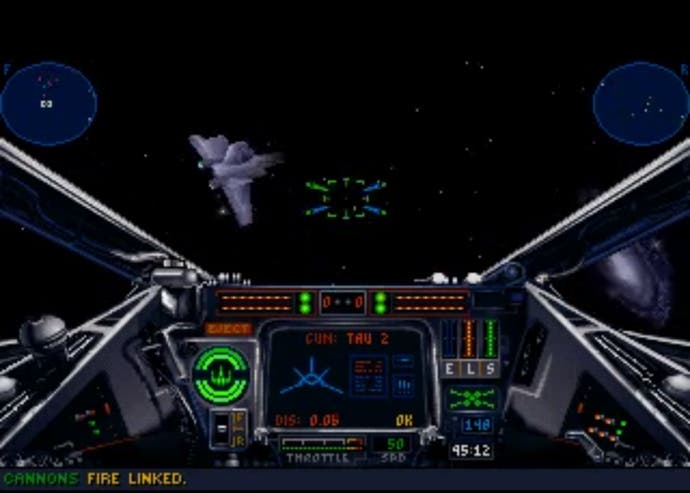
Throughout the '80s, Star Wars had incredible cultural penetration. Perhaps it was the growing popularity of the videocassette that helped bring it to a generation who, like me, had been a little too young to catch it in the cinema but who loved it no less. Ten long years after Return of the Jedi, X-Wing gave us a new reason to remember and to celebrate the excitement of those films, of that universe, and it did this so much better, so much cooler than the tepid and slightly embarassing TV efforts we'd endured growing up.
It was video games that kept Star Wars cool, that kept it exciting and perhaps even kept the franchise alive. X-Wing was the best of them, the first and most faithful of these torchbearers. With TIE-Fighter, Supremacy and Dark Forces following, the Star Wars of the '90s began to feel as vibrant of that of the '70s, growing deeper and broader as we adventured within it, as we battled for freedom and justice in that galaxy far, far away. Then, in 1999, a computer-generated clown stepped in some poo, and Lucas would strip away much of the gravitas and grandeur that his creation had earned. His work may've been high fantasy, but it wasn't supposed to be high camp.
When 1313 was revealed, I wondered if it could be the X-Wing of its generation, if video games might make Star Wars cool once again. Whether they do or do not, the announcement of a game that is supposed to bring a change of tone to the franchise, that claims to be more "mature", is really an all-to telling-indication that what Star Wars most needs is what Lucas will likely never grant it, that same treatment that Star Trek, Doctor Who and Battlestar Galactica received. Star Wars needs a reboot.
